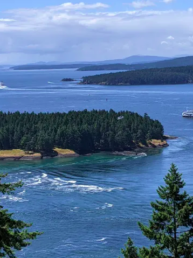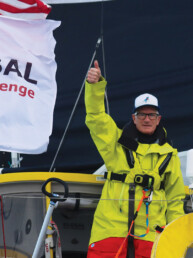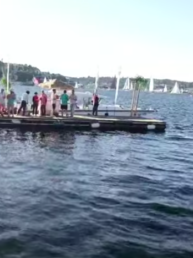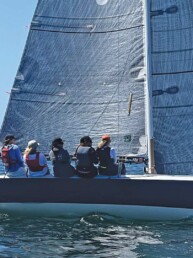 David Linger and I started at the end. “The flares only burn for about 30 seconds, and I saw how another competitor held two in one hand and pulled both tabs at the same time. There’s a little bit of slag coming off of ‘em. You’re in the back of the boat, you don’t want to stick it in the sail, you don’t want to drop the slag on the Starlink antenna or yourself, and then you’re trying not to fall in. For the last five months you’ve been holding on with one hand, and Marco is yelling at me to look at the camera.”
David Linger and I started at the end. “The flares only burn for about 30 seconds, and I saw how another competitor held two in one hand and pulled both tabs at the same time. There’s a little bit of slag coming off of ‘em. You’re in the back of the boat, you don’t want to stick it in the sail, you don’t want to drop the slag on the Starlink antenna or yourself, and then you’re trying not to fall in. For the last five months you’ve been holding on with one hand, and Marco is yelling at me to look at the camera.”
Dave’s vivid description of the photo shoot as he approached the finish line of the Global Solo Challenge (GSC) in A Coruña, Spain set the tone for our delightful and fascinating conversation to follow. Due to the recency and scale of his achievement, this local sailor seemed to be reflecting on his enormous adventure in component parts. “It still hasn’t totally sunk in yet,” he remarked.
“What was going through your head when you crossed that finish line?” I asked.
“If I crack off another 5 or 10 degrees, I’m going to outrun the RIB.” Dave continued, “The motif that we bring to any regatta is, ‘Sail every race, and try not to look like a fool getting on and off the dock.’ So, I finished the event and I’m already thinking about whether I’m going to go straight into the slip, or am I going to back in, or…? Oh, there’s my girlfriend, ‘Hot damn!’”
Seattle’s most recent circumnavigator—his, an epic 175-day voyage completed solo and very nearly non-stop (save for a brief pause to repair a broken boom just after Cape Horn) on his Class 40 sailboat, Koloa Maoli—sat comfortably on deck of his floating home on Lake Union when I joined him just over a month after he completed his voyage.
Dave’s home has a rustic maritime modesty that is paired with its luxurious location at the end of an Eastlake dock, with the glistening urban waterway providing what he called, “complete problematic distraction.” He’s been coming to this house since he was 6 years old, and it has been his for more than 15 now. The place struck me as perfectly suited for its unassuming owner whose quirky humility and authentic character are balanced, now more than ever, by the rarified air of spectacular accomplishment and international acclaim as a finisher of a singlehanded round-the-world sailing race.
Dave described himself as “quietly competent” and “deeply read.” Each of those qualities are continuously evident, and I’d add that Dave is all heart, too. Still focused on the closing days of his voyage, he was soon choked up and wiping away a couple of tears. “Two days before I finished, the competitor in the Cap Martinique Race, Phillipe, got washed off his boat and died. And the next day, I sailed past where he had lost his life. I made a little toast to him and his family. That was super hard.” At this and other moments of significance, Dave—who has been sober for many years—offered a bit of his girlfriend Lillian’s bottle of rum to the ocean, which he carried for such occasions. “It was a very long three days coming up the coast. You see the lighthouse, and you’re like, ‘Yeah, I f*cking did it.’” Yes you did Dave, you sailed around the world singlehanded. Whoa.
Student of History

Any discussion of Dave’s recent achievement understandably begs the question, “Why?” Dave shared a lot of ideas about how he came to this, and repeatedly mentioned that he’d wanted to sail around the world since he was a child. But even understanding that desire reveals a person dedicated to learning, reading, and honoring what’s come before.
Dave grew up on Lake Union on the northside of Queen Anne hill. “I wasn’t interested in superheroes growing up because I was able to read about people that had adventures. I always wanted to go on an adventure. Eric Tabarly, Maud Fauntenoy, Clare Francis, Chichester’s articles—there’s a whole list. Before I was born, my parents already had a library of National Geographics dating back to the 1920s. Thousands of them. I grew up reading Robin Lee Graham, the author of Dove, because that was serialized in National Geographic. I thought it was super cool that this kid was going sailing across the ocean.” Dwelling on this, Dave paused for a moment, clouding up once more. “Guzzwell,” he said plainly, “Trekka.” He nodded, trailing off.
As we talked, Dave’s fluency in so much that has come before was on constant display—local and global, regarding boats and the maritime world and many, many things outside of it. This profound connection to the past matters so much because it ties Dave’s voyage not only to his childhood dream, but to those adventurers who offered him a lifetime of inspiration.
A Maritime Life
In work and play, Dave Linger has spent the majority of his life involved with boats and the water. “I had a little pram that my father and I built when I was in grade school, and started sailing then. I learned a lot about sailing at the CYC sail school at Leschi. Later in high school, a group of my friends had racing lessons at Seattle Yacht Club.”
Dave raced El Toros on Green Lake, including a 65-boat North American Championship there. He got further into competitive sailing in high school, qualifying for and sailing the Sears Cup in Cleveland. And, thanks to a victory at the C-Lark Junior Championships, he sailed the Youth Championships in 1979 and 1980.
By that time, he had also begun working in the industry. “I started washing boats for York Yachts in Fremont, which was the San Juan dealer and the Nonsuch dealer. One thing leads to another, somebody asks you to hold the bolt while they put a piece of deck hardware on.” He moved on to work for Sailboats Northwest, the original J/Boats dealership. He got to know riggers and divers. He says, “then you get a job working at a power boat dealership and learn about that.” During our conversation he referred to his work Kvichak Marine and West Marine, among a number of well known local maritime institutions.
Wherever his work took him, Dave never stopped sailing. “I got a Santana 20, raced on the Sound, raced it Duck Dodge. And I raced on my father’s boat—he had a Coronado 25, and then the boat right here (gesturing to the dock behind him) the Ranger 33 has been in the family for 40 years.”
In the 1980s, Dave started doing deliveries. Though one of his first discoveries was that he gets seasick, his appetite for ocean sailing was officially whetted. That first delivery was from Hawaii to Puget Sound on Chimera, a tiller-driven two-tonner that had just sailed the Vic-Maui race. Other takeaways from that first trip still reverberated on his circumnavigation: “I learned if it’s windy, hold on. Sail strong, fast boats on the ocean. The tiller means you learn a lot about balance, that the boat shouldn’t be cranky. Don’t pinch when you’re on the ocean, keep the bow down because you’re going to pound less.”
In the years since, Dave has continued to keep his offshore steel sharp. In addition to many ocean deliveries, the longest being a 21-day passage from Tonga to Hawaii, Dave has done several shorthanded Hawaii races of his own. The foundation for the big adventure he’d always envisioned was solidified.
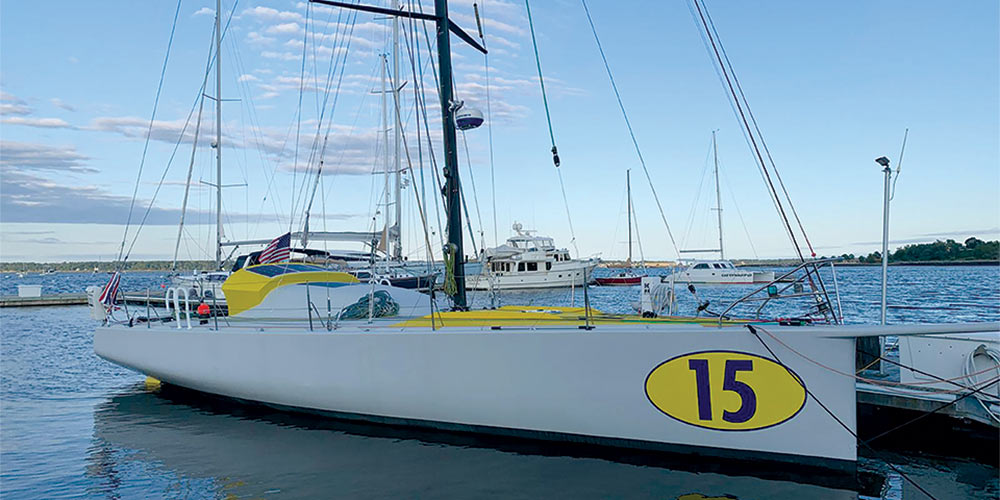
The Good Ship Koloa Maoli
For Dave, it was a confluence of all the right factors—time, resources, and an event aligned and led him to Koloa and eventually around the world. When he first learned of the GSC, “A little lightbulb came on, maybe I can do this…. But you kind of ignore the singlehanded non-stop around the world thing, because that’s really a big thing.” He appreciated that the GSC was advertised as an event more than a race, even though it was racing. While his lifelong dream to circumnavigate hadn’t been focused on a race format, he noted that with an event, “There’s a start date. I’m the kind of person who would procrastinate until I couldn’t physically sail the boat, I’d be too old.”
So the search for a Class 40 was on, a class of ocean racing boat he’d followed since its inception 20 years ago, and which it seemed many fellow competitors were choosing for the GSC. About three years before the start of the GSC, Dave was in Spain for the 6 Meter World Cup, and learned of a Class 40 available in northern Spain. Shortly thereafter, another came up in Maine. “Lillian advised that I ignore the boat I’d been looking at in Spain because it was too many time zones away. Maine was manageable.”
The boat in Maine would be his chosen vessel, and came with several advantages. The Owen Clark design had two near-sisterships in the race. It was at the East Coast’s top Class 40 yard, Maine Yacht Center, being cared for by someone who had circumnavigated on a Class 40 himself.
Though he had never sailed a Class 40 when he bought the boat, he found it fairly close to his expectations: “It’s a 40-foot boat, draws 10 feet, and it has 750 liters of water ballast, so you know it’s going to be pretty powerful. It’s a little underperforming in light, light air. In any kind of breeze they power right up and are exciting to sail.”
Never one to let history stray very far from his mind, Dave notes: “What’s funny about the Class 40 is that, in 1969, Eric Tabarly raced a boat across the Pacific, Pen Duick V, and beat the next competitor by something like 10 days. His boat was 35 feet long, made out of aluminum, it had a continuous chine along the waterline from bow to stern, it had a bulb keel and a trim tab, a spade rudder, and it had water ballast. So there’s nothing new. It’s all been done before.”
In that highly experienced yard, Dave received expert advice and assisted with a refit that included adding a hard dodger cockpit covering, replacing the rod rigging, and updating much of the running rigging. From the yard’s circumnavigators, he learned, “If you’re alone, heat might be nice,” so they added a diesel heater. Dave’s delivery background had shown him that “transferring fuel from jugs to tanks is my least favorite thing to do.” So, while the 80-liter fuel tank on his boat was already almost twice the size of the stock tank on many Class 40s, he increased fixed tankage, adding “a 62-liter version on each side, one for the heater and one for the engine.” The refit included a variety of other preparations like bottom paint and sail plan work, and many projects centered around having system redundancy, from power—two hydrogenerators and solar—to communications—Yellowbrick tracker with text capability, Garmin InReach, Iridium Go, Starlink, and a sat phone.
In the late summer of 2023, Dave boarded Koloa Maoli solo and set off for a 17-day Atlantic crossing. His longest solo voyage and qualifier for the GSC represented only about 10% of the full loop for which he would depart a few months later.
Check back next month for the stories of Dave’s voyage around!
Joe Cline is the Managing Editor of 48° North.
Joe Cline
Joe Cline has been the Managing Editor of 48° North since 2014. From his career to his volunteer leadership in the marine industry, from racing sailboats large and small to his discovery of Pacific Northwest cruising —Joe is as sail-smitten as they come. Joe and his wife, Kaylin, welcomed a baby girl to their family in December 2021, and he is enjoying fatherhood while still finding time to sail, make music, and tip back a tasty IPA every now and again.

